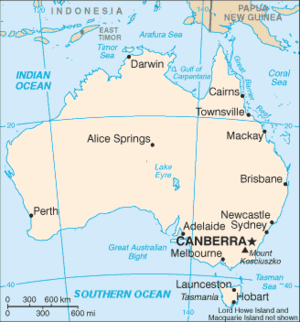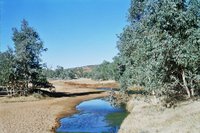Alice Springs, Northern Territory
|
|
Alice Springs is a large town in the Northern Territory of Australia located at Template:Coor dm. Its population of 28,178 (2001 Census) makes it the second-largest settlement in the Territory (the only other towns of significant size are Darwin, the capital, and Katherine). It is popularly described as "the Alice" or simply "Alice". Alice Springs is known as Mparntwe to its traditional owners the Arrente.
| Contents [hide] |
History
Alice Springs is best known outside the region as the setting of the Nevil Shute novel A Town Like Alice, and because of its proximity to Uluru, formerly known as Ayers Rock, the monolithic hill that is one of Australia's best-known natural landmarks as well as an important focus of Aboriginal culture and beliefs.
Originally named Stuart, the town was established almost as a frontier settlement for north-south travel by camel trains through the desert of the outback. A telegraph station was placed near a permanent waterhole called Alice Springs (see photograph) after the wife of Sir Charles Todd, Postmaster General of South Australia, after whom the River Todd (which is usually dry) was named. The Ghan railway from Adelaide reached Stuart in 1929, and the town moved away from the waterhole, but locals kept the name. In 1933, after much debate, the town of Stuart was officially renamed Alice Springs. The north-south road between Darwin, Alice Springs and Adelaide is still called the Stuart Highway.Almost in the exact center of the continent, Alice Springs is some 700 kilometres from the nearest ocean and 1500 kilometres from the nearest major cities: Darwin and Adelaide. Alice Springs is now the midpoint of the Adelaide-Darwin Railway.
During the 1960s it became an important defence location with the development of the U.S/Australian Pine Gap joint defense satellite monitoring base, home to about 700 workers from both countries, but by far the major industry in recent times is tourism.
Alice_landsat.JPG
Demography
Itinerant population
Alice Springs has a large itinerant population made up of:
- Tourists
- Residents of Pine Gap
- Australian Aborigines visiting from nearby Central Australian communities
- Australian or international workers on short-term contracts (colloquially referred to as "blowflies")
American influence
The American influence in Alice Springs comes primarily from the proximity to Pine Gap, a US satellite tracking station, located 19 km south-west of Alice Springs. While Pine Gap employs 700 American and Australians, there are currently 2,000 people in the Alice Springs district who carry citizenship of the United States of America. As well as family members accompanying those posted to Pine Gap, many Americans move to Alice Springs to live after serving their terms in Pine Gap, or perhaps due to the existing large proportion of Americans living in Alice Springs.
American influence can be seen throughout Alice Springs, which celebrates all major American festivals, including Halloween, Independence Day and Thanksgiving. There are is also a large influence of American culture in sport, including baseball and American football competitions, which live alongside more Australian sports of cricket, Australian football and rugby [1] (http://www.alicesprings.nt.gov.au/about_alice/american.asp).
Aboriginal population
According to the 2001 census, Australian Aborigines make up approximately 17% of the population of Alice Springs, and 29% of the Northern Territory. [2] (http://www.alicesprings.nt.gov.au/about_alice/about_sum.asp) As Alice Springs is the regional hub of Central Australia it attracts Aboriginal people from all over that region and well beyond. Many Aborigines visit regularly to use the town's services. Aboriginal residents live in the suburbs, on special purpose leases (or town camps) or further out at Amoonguna to the South and on the small family outstation communities on Aboriginal Lands in surrounding areas.
Aboriginal Centralians have had relatively little time to adapt to European settlement. European exploration of the region did not begin until the 1860's and the European population here was only small in mnumber until well into the twentieth century. Aboriginal families were still coming out of the desert, coming into contact with White Australia for the first time as late as the 1960's, with the last family emerging from the Gibson Desert in 1984. [3] (http://www.alicesprings.nt.gov.au/about_alice/aboriginal.asp) The combination of extremes of cultural difference and resulting drastic enforced change over a short period of time has resulted in serious social and economic problems for Indigenous Australians in Alice Springs as much as anywhere else in Australia. Many government and non-government organisations work to help Aboriginal citizens cope with and overcome the difficulties they face.
Tourism
The primary reason for tourism to Alice Springs had been its proximity to Uluru, which is 400 km to the West. However, with the creation of Yulara resort in 1984, and an airport allowing tourists to fly directly to Yulara, many tourists no longer visit Alice Springs. Alice Springs had also been used by many Australian tourists as a stopover point between Darwin and Adelaide or Brisbane and Perth, but the airlines now prefer to fly directly to their destinations.
Alice Springs has a large number of tourist resorts, a casino, the Araluen arts centre and museum, nightclubs, clubs, pubs, restaurants and cafes. Visitor attractions include a Desert Park wildlife centre, Open Air Ballooning, Camel Tours, a Reptile Centre, a Cinema. Also supporting the tourist industry are over a dozen hotels, caravan parks and backpacker lodges, as well as tourist centres that run tours to Hermannsburg, The Olgas, Ayer's Rock, King's Canyon, Wallace Rock Hole and a number of other places. (ref: [4] (http://www.alicesprings.nt.gov.au/about_alice/lifestyle.asp))
Alice Springs is host to a large number of festivals, including the Finke Desert Race and the Todd River Race that are held annually (ref: [5] (http://www.alicesprings.nt.gov.au/tourism/events.asp)).
Much traditional Aboriginal artwork from the neighbouring Central Australian communities, including artefacts and Dreamtime stories is for sale to tourists in Alice Springs. (ref: [6] (http://www.alicesprings.nt.gov.au/tourism/tourism.asp))
Economy
Alice Springs has a booming economy and is one of Australia's wealthiest towns. Major inputs to the economy include:
- Tourism, especially related to Uluru, which gives Alice Springs 500,000 tourists per year (ref: [7] (http://www.alicesprings.nt.gov.au/about_alice/lifestyle.asp))
- The significant government funding in relation to the high traditional Aboriginal population
- Income derived from Pine Gap adds $12 million per year to the economy (ref: [8] (http://www.alicesprings.nt.gov.au/about_alice/american.asp))
Climate
Temperatures vary by an average of 20 degrees Celsius from minimum to maximum on any given day. In summer, the temperature typically reach the low 40s degrees Celsius maximum (but can be as high as 48), while in winter it can drop to as low as -7 degrees Celsius minimum (and has been reported to be as low as -10). The climate is arid, with little or no rainfall, although the amount of rainfall varies enormously from one year to the next. The climate is generally very dry, with little or no humidity. (ref: [9] (http://www.alicesprings.nt.gov.au/about_alice/climate.asp) Alice Springs: climate)
Crime
In 1985/1986, 70% of the prison population was Aboriginal. The majority of crimes committed by Aborigines in Alice Springs was against other Aboriginal people, often alcohol-related. Attempts have been made to allow Aborigines in Alice Springs to use customary law as a defence (for example, payback or traditional customs) but thus far this has failed. Alice Springs has been linked with the Azaria Chamberlain disappearance and Peter Falconio disappearance in nearby Uluru and Barrow Creek.
References and further reading
- Guth, Henk. 1985. Alice Springs As It Was: In Old Photographs. Panorama Guth, Alice Springs.
- The Submission of the Northern Territory Aboriginal Issues Unit of the Royal Commission into Aboriginal Deaths in Custody to Commissioner Elliott Johnston, QC, July 1990 (http://beta.austlii.edu.au/au/other/IndigLRes/rciadic/national/vol5/11.html)
See also
External links
- Alice Springs: official site (http://www.alicesprings.nt.gov.au/)
- Alice Springs Town Council site (http://www.alicesprings.nt.gov.au/council/council_sum.asp)
- About Alice Springs (http://www.alicesprings.nt.gov.au/about_alice/about_sum.asp)
- Indigenous Law Resources (http://beta.austlii.edu.au/au/other/IndigLRes/rciadic/national/vol5/11.html)de:Alice Springs
gl:Alice Springs nl:Alice Springs ja:アリススプリングス pl:Alice Springs sv:Alice Springs


